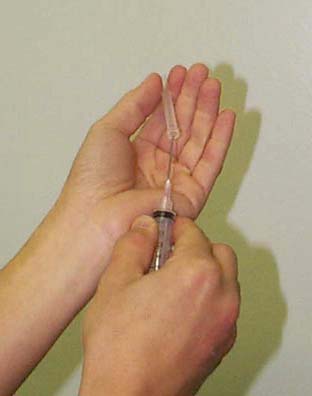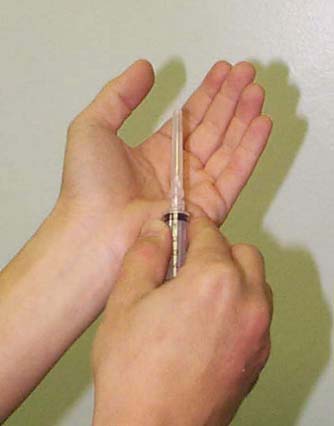| First, hold the the cap distally at the closed end between the thumb and index finger of the left hand. While holding the syringe and needle in your right hand, guide the needle tip until it is just past the entrance of the cap. |  |
For example, we may use a larger needle to draw up the diluents and then change the needle to a smaller one when injecting the solution. This is to avoid puncturing the IV tubing or rubber bung in the spigot with a large needle which will lead to leaking from the rubber especially with multiple injections. The maximum needle size that may be used while still avoiding leakage is probably 21 G for the spigots and 23 G for IV lines.
If the needle accidentally touches an unsterile surface, it may also be necessary to change the needle to maintain sterility.
Also, if you leave your syringes on the anaesthetic trolley for later use, you may prefer to recap it to reduce the chance of getting pricked.
Another instance when recapping may be preferable is when you have cannulated a patient in the holding bay and the sharps container is full. It may then be better to recap the needle for transportation to the OT to reduce the chance of a needle prick.
One method often recommended is to place the cap on the table or trolley and recap the needle with only one hand holding the needle/syringe.
Here's another method I have found that has worked well for me.
| First, hold the the cap distally at the closed end between the thumb and index finger of the left hand. While holding the syringe and needle in your right hand, guide the needle tip until it is just past the entrance of the cap. |  |
 |
Next, release the cap from your left hand, allowing it to fall down over the needle by gravity. Do not push the cap down or advance the needle upwards. This makes it almost impossible for the needle to puncture the cap as the weight of the cap is insufficient to force the needle through the cap material. |
| Lastly, shift the grip of the left hand to the proximal end of the cap (the open end) and after visually checking to make sure that the needle is not impinging on any of the side-walls of the cap, push the cap and needle together until they click together. Make one final check that the needle has not punctured the cap and you're done. |  |
By the way, please avoid carrying needles in your pockets. Use your anaesthetic tray.
If you do use this technique, please remember that you do so at your own
risk.